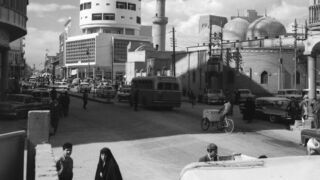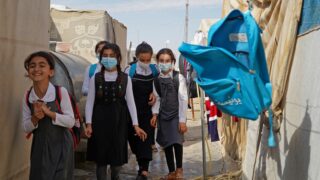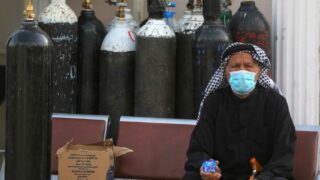
This publication has benefited from the support of the Rosa Luxemburg Foundation. This text may be reproduced in part or in full, provided the source is acknowledged.
Natural Herbal Medicine Created by Herbalist Sayyid Ali al-Mouali al-Musha’sha’i. This entire phrase is the name of Sayyid Ali’s page on Facebook. “Sayyid Ali”, who wears iqal and lives in the city of Samawah in Al Muthanna Governorate (270 km south of Baghdad), has become famous beyond his dreams. A video taken of him is to be thanked. In it, he treats elderly people infected with the coronavirus in his own manner: he would rip the masks off of their faces, then kiss their mouths in a performative way. He wanted to make a point out of his triumph over the virus.
“Sayyid Ali” didn’t enjoy his newly found fame for long, however. After this clip was shared on social media, reaching many, he was arrested, and the Department of Justice mouthpiece stated that the Samawah Court of Investigations sanctioned his statements and acted in accordance with the provisions of Article 368 of the penal code. “He deceived and deluded people of being capable of treating Covid-19 and other diseases through herbs, without any official authorisation”.
After his release on bail, “Sayyid Ali” went on a televised interview with a copy of the Koran. Sad and tearful, he didn’t attempt to hide his suicidal thoughts. He denounced the way he was arrested, as if he were a “terrorist”.
He also spoke about the herb he used in treating his patients: “After my son was infected with Covid-19 and his condition became critical, I remembered an herb that our ancestors would use to treat sick sheep”. He also said that he headed to the Covid-19 quarantine centre in his governorate, Al Muthanna, to treat patients there during the first wave of Summer 2020, claiming to heal “officials and high-ranking officers” of the governorate.
A history of manufacturing ignorance. Whose fault?
“Sayyid Ali” isn’t the first story of fighting off the coronavirus with myth, however. Days after the disease first appeared in Iraq, on February 24th, 2020, it was widely circulated that harmal (peganum harmala/wild rue) would be effective in eradicating the disease. This opened the door to a host of other myths, of which Sayyid Ali al-Musha’sha’i’s wouldn’t be its last.
Even as the virus kills humans all over the world, and one year into its emergence in Iraq, many still believe that it is a political invention fabricated by the “infidel West” to control our resources. Still, even as some half-believers do acknowledge that the “virus is a real one”, they concoct their own version of nonchalance to underestimate prevention methods. In Sulaymaniyah, for instance, in Kurdistan Region in northern Iraq, one of the calmest, safest, and home to the most progressive healthcare services – in comparison with the rest of Iraqi regions sinking into calamity – should you walk around wearing a face mask, you’d be a sight to behold. You won’t find many who wear it, and, so, would rather seek protection in conformity.
“Sayyid Ali” isn’t the first story of fighting off the coronavirus with myth. Days after the disease first appeared in Iraq, on February 24th, 2020, it was widely circulated that harmal (peganum harmala/wild rue) would be effective in eradicating the disease. This opened the door to a host of other myths.
Neither society nor people are at fault for what’s befallen them. I draw on such a concept to read the case of Iraqi society in the face of this fatal disease.
How come Iraqi society lacks health awareness?
An answer to this question would call for another series of questions, which are, perhaps, at its root: Why are healthcare levels in decline? Why is public health deteriorating? Why do Iraqis have no hospitals, or healthcare centres fit for human use? What spaces do they inhabit and what do they drink? What’s the basic infrastructure like in the country? Why is school health in decline or, rather, completely lacking? And so on, so forth, until we reach the final question, leading to one bulky answer: Successive authorities that rule Iraq with force and corruption.
Manufacturing ignorance for survival
Lately, public opinion was disturbed when Iraq made no appearance in the 2021 School Education Quality Index. The Office of the United Nations High Commissioner in Iraq considered such absence to be a “setback to education”, although the majority of recent years have had Iraq missing from such lists. Iraqi authorities have always considered such absence as normal, rather than indicative of its failure in creating good educational institutions. Likewise, they handle Iraq’s nonappearance in all life’s indexes of quality in the aforementioned manner. When Iraq does make an appearance in such indexes, however, the authorities celebrate it for its mere presence therein, untroubled by the country’s low ranking. Successive Iraqi authorities thus manufacture health “unawareness” as they do a “non-life”.
Even as the virus kills humans all over the world, and one year into its emergence in Iraq, many still believe that it is a political invention fabricated by the “infidel West” to control our resources.
It could come as a surprise then that Iraq has a public health law – Public Health Law no. 89 (1981). However, it indeed is nothing but a law. Its entire Article 9 addressed school healthcare, maintaining the following:
First: “Provide a healthy environment fit for learning”. No environment fit or healthy for learning, however, could ever mean lack of functional bathrooms in school buildings.
Second: “Provide preventive healthcare services to children, learners, students, and those who work with them”. In reality, though, nothing is ever provided, except some limited vaccination campaigns, while public schools have no first aid kits, for instance.
Third: “Include healthcare and environmental subjects in school curricula and throughout the educational process”. Power-sharing authorities and militias, however, replaced Saddam’s curricula with “power-sharing” curricula, through which they passed on their icons and ideologies, while children’s health awareness never crossed their minds.
Iraqis are brought up with claims that they are raised to be aware of the significance of health and scientific knowledge. Such declarations are all discarded, though, pushing Iraqis towards submissiveness, rendering them numbers with a herd mentality in a tamed society. They watch as authorities break their own vows and laws. When observed in that light, all passages of the Public Health Law are rendered a joke, starting with Article 1 that states that “Comprehensive physical, mental and social fitness, is a right that society guarantees all its citizens. The state must provide the means to guarantee it, so that its citizens are able to participate in community building and development”. The third is equally divorced from reality, which branches out to address family, childhood, motherhood, and old age healthcare, along with mental health, physical fitness, medical provisions, institution building, and ensuring nutritional standards by which individuals and society may live. One needn’t even read through Article 9, which addresses the gag of healthcare in schools, or examine the extent to which the authorities are committed to applying all such laws.
Communal or individual healthcare is no priority to Iraqi authorities, and neither is educating society or raising its awareness. Those, specifically, would in fact harm their bigger enterprise – that of selling superstitions and virtues.
An explosion just around the corner
In the manner of “Each newborn brings along their own daily bread”, intentional manufacturing of ignorance is complemented with a population growth that exceeds inflation and is rapidly heading for an explosion. According to the Iraqi Ministry of Planning, population growth rates have passed the 3 percent mark, and the Iraqi population has grown past 41 million: it grows at a rate of more than one million a year. In 2018, the population index showed a rate of 1 km2 per 89.9 capita. The Minister of Planning stated that the current number of residents in the Iraqi capital alone, Baghdad, has reached 9.5 million, and 13 million by daytime, with more people hailing from other regions and provinces for the day.
The majority of the 9.5 million are spread over small neighbourhoods, designed to absorb a quarter of such a number, while the capital contains nearly 4 million cars, rendering Baghdad as constantly overcrowded. Housing shortages are more frequent, especially in areas by the city centre or adjacent to important Iraqi governmental institutions, like ministries, citizenship departments, or commercial markets. Even if available, housing prices and rental costs are extremely high.
In May 2020, the Women and Family Committee of the Iraqi parliament adopted a proposition that devised a plan to distribute bursaries to young married couples in return for their commitment to “birth control and family planning”. The committee warned that the country was headed for a “population explosion” in case this matter wasn’t quickly resolved. However, the project never went beyond the limits of statements and warnings. Little financial leeway is available to allow for it anyway, and Iraqi society isn’t culturally prepared to accept or consider it.
Due to the mounting housing crisis, an inflated Iraqi population lives in extremely tight spaces.
To live in a “non-space”
This crisis has pushed Iraqis to resort to temporary or patchwork solutions. For example, house-splitting has been a normal phenomenon; houses are parcellated into such small homes to the point where some were sized down to no more than 30 m2, which, along with other factors, further erases urban features. Arguably, urban identity is sacrificed to guarantee housing, even if uninhabitable. Massive shantytowns also grew by urban peripheries and their green spaces, counting more than 3 million people across Iraq, according to the Central Organization of Statistics.
Population growth exceeds inflation and is rapidly heading for an explosion: according to the Iraqi Ministry of Planning, its rate has passed the 3 percent mark, and the Iraqi population has grown past 41 million. It grows at a rate of more than one million a year.
In parallel, housing projects, which the state rolls out or in which it offers opportunities to invest, have been growing at a rate disproportionate with the increasing demand, but are simultaneously not divorced from Iraqi real-estate market dynamics: they, too, are highly priced, and scarce.
In all its governorates, Iraq lacks domestic transportation systems, like a metro or a tramway. To move around, people rely on their private vehicles and taxis, whose numbers have exceeded roadway and environmental capacities, or buses and carpooling, most of which are “Kia cars”, or so they’re called as the first such known vehicle was a Korean-made Kia model – a small 11-14-seater.
To a limited extent, people also use large buses to move around, often owned by the public transportation company that transports travellers and delegations affiliated with the Iraqi Ministry of Transportation. According to the last report issued by the Central Organization of Statistics, in 2019, the number of those buses reached 1,891, 576 of which were double-deckers. In 2019, as Iraqi railway networks reached 2,893 km in length, only 435 thousand passengers used them – as opposed to 529 thousand passengers in 2018, thus recording a drop of 17.8 percent.
Eventually, following an exhausting trip through the ramshackle streets of their country, Iraqis do reach home –but sometimes never do– to start yet another journey of hardship, which opens with power cuts, and stops at nothing.
Non-services
Overall, regardless of the type of their lodgings, Iraqis suffer doubly from a severe shortage of services that the state is supposed to provide, while their regions suffer from antique and insufficient infrastructure.
With every rainfall, and sometimes without, wastewater overfloods Iraqi areas, without exception. Even some luxury neighbourhoods suffer damages way harsher than popular neighbourhoods do. Citizens are thus forced to channel their anger into sarcasm, devising their own rowing boats and mashaheef (ancient Mesopotamian canoes) in an attempt to cross over their pain.
Following an exhausting trip through the ramshackle streets of their country, Iraqis do reach home –but sometimes never do– to start yet another journey of hardship, which opens with power cuts, and stops at nothing.
According to the Ministry of Planning, the percentage of the population serviced through shared public sewage systems is 34.5 percent, while the percentage of people reliant on independent and primitive water treatment systems has reached 55.5 percent (a system that depends on storing heavy water in a waterproof cellar then emptying it out once full). Only 30 percent of the population is serviced with treatment plants, 10 percent of the population is downright serviced with no sewage system whatsoever, whereas only 41.7 percent of Iraqis enjoy rainwater networks.
The areas serviced with sanitation or rainwater networks are no exclusion to the crisis. Those are old networks, most of which are more than 40 years old, designed to accommodate less than half the present houses and population. Furthermore, another problem manifests in heavy water treatment; in Iraq, the number of central treatment plants and medium and small treatment units is 64, and Baghdad is home to their biggest number – 11 plants. In 2019, the percentage of wastewater generated in the suffocating capital and treated in heavy water plants never exceeded 60 percent. This results in some sewage piped into the rivers, raising contamination levels of water, to which Iraq has scarce access, and which is cut off from houses for a number of hours per day.
Some wastewater outlets transform into enormous rubbish dumps, as has the part that shantytowns haven’t reached. Those empty spaces deigned to provide urban breathing room are turned into huge landfills that accumulate garbage.
According to the Ministry of Planning, the percentage of the population serviced through shared public sewage systems is 34.5 percent, while the percentage of people reliant on independent and primitive water treatment systems has reached 55.5 percent (a system that depends on storing heavy water in a waterproof cellar then emptying it out once full). Only 30 percent of the population is serviced with water treatment plants.
All across Iraq, there are 67 officially authorised spots designated for waste treatment, but the number of unlicensed spots has reached 157. All of them have adopted a method of burying waste underground. The normal percentage of waste buried in unlicensed spots has reached 87.5 percent of waste in Iraq. All the while, only 63.6 percent of Iraqis enjoy garbage collection services, and even that service is a chaotic and unregulated process of collection. No sorting takes place and no commitment is made to collect garbage from residential areas at a set time. Residents are sometimes forced to pay garbage collectors their fees, while some garbage collection teams have even turned themselves into semi-companies, receiving elevated monthly fees in return for their waste collection services.
A deadly life
All of the above and much more worries Iraqi citizens and imbeds them into a bottomless spiral of individualised solutions to problems or finding ways to coexist with them. Hand in hand with other factors, those contribute to disease and epidemic outbreaks and raise the chances of death by multiple causes. Governmental institutions are headed by leaders busy benefitting their own parties, indifferent to the health of their communities and citizens.
The percentage of wastewater generated in the suffocated capital and treated in heavy water treatment plants never exceeded 60 percent. This results in some sewage piped into the rivers, raising contamination levels of water, to which Iraq has scarce access, and which is cut off from houses for a number of hours per day.
This precisely is the present case of Covid-19 in Iraq. Some parties invested in the outbreak and tried to promote themselves through empty campaigns, like distributing aid to families affected by the lockdown, and giving out oxygen cannisters for cameras to watch. Such campaigns turned into billboards for the concerned parties and their organisers (like the popular mobilisation committee); they filled up public space, to remind Iraqis that they were indebted to them.
Besides Covid-19 and weapons, there are numerous other ways to die in Iraq. The first ten, as per the Ministry of Planning, are: 1- Ischaemic heart diseases, 2- Tumours, 3- Brain disease, 4- High blood pressure, 5- Other forms of heart disease, 6- Kidney failure, 7- Traffic accidents, 8- Diabetes, 9- Neonatal coronary, respiratory, and vascular disorders, 10- Other bacterial diseases.
In 2019, the overall death rate induced by the abovementioned list reached 64.16 percent of the overall number of Iraqi deaths. To treat them, all such diseases require an integrative healthcare system and, more so, need a solid health education. This is where Iraqi authorities fail time and again. By June 8th, 2021, the number of Covid-19 deaths reached 16,586, whereas people’s vaccination turnout remains low. A large percentage of patients remain home-ridden, or under the custody of Sayyid Ali al-Mouali al-Musha’sha’i and his likes, who penetrate a significant swathe of Iraqi minds and even the minds and convictions of some of Iraq’s new leadership.
The content of this publication is the sole responsibility of Assafir Al-Arabi and Rosa Luxemburg Foundation cannot accept any liability for it.
Translated from Arabic by Yasmine Haj
Published in Assafir Al-Arabi on 10/06/2021






